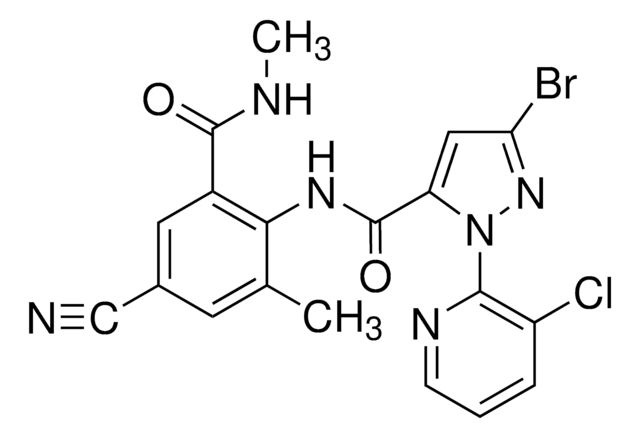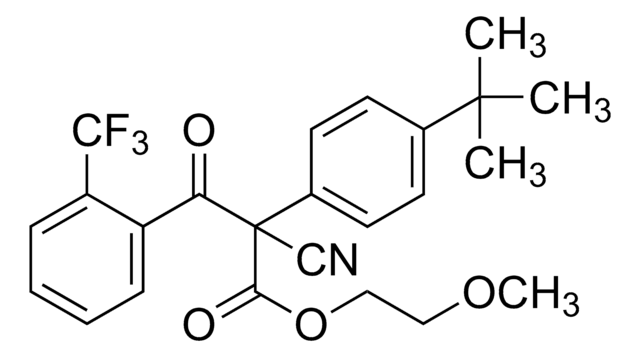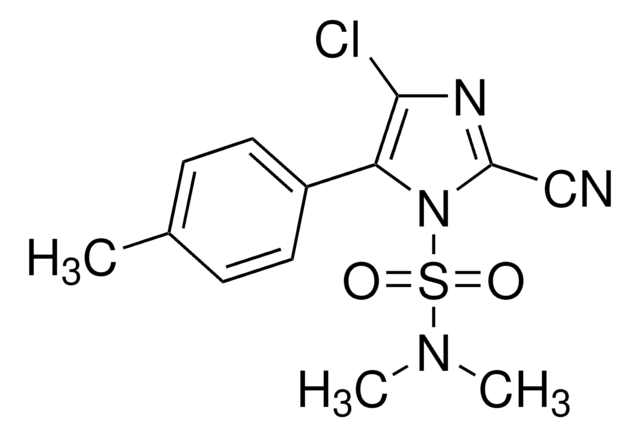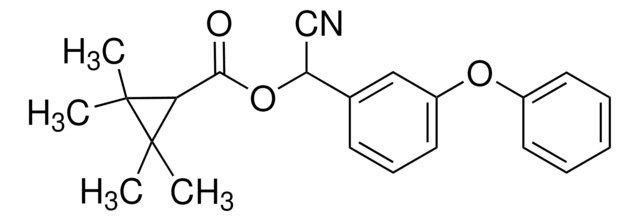Key Documents
CRM01303
Cyantraniliprole
certified reference material, TraceCERT®, Manufactured by: Sigma-Aldrich Production GmbH, Switzerland
Synonim(y):
3-Bromo-1-(3-chloro-2-pyridyl)-4′-cyano-2′-methyl-6′-(methylcarbamoyl)pyrazole-5-carboxanilide
About This Item
Polecane produkty
klasa czystości
certified reference material
TraceCERT®
Poziom jakości
linia produktu
TraceCERT®
okres trwałości
limited shelf life, expiry date on the label
producent / nazwa handlowa
Manufactured by: Sigma-Aldrich Production GmbH, Switzerland
temp. przechowywania
−20°C
ciąg SMILES
O=C(C1=CC(Br)=NN1C2=C(Cl)C=CC=N2)NC3=C(C(NC)=O)C=C(C#N)C=C3C
InChI
1S/C19H14BrClN6O2/c1-10-6-11(9-22)7-12(18(28)23-2)16(10)25-19(29)14-8-15(20)26-27(14)17-13(21)4-3-5-24-17/h3-8H,1-2H3,(H,23,28)(H,25,29)
Klucz InChI
DVBUIBGJRQBEDP-UHFFFAOYSA-N
Szukasz podobnych produktów? Odwiedź Przewodnik dotyczący porównywania produktów
Powiązane kategorie
Opis ogólny
Certified content by quantitative NMR incl. uncertainty and expiry date are given on the certificate.
Download your certificate at: http://www.sigma-aldrich.com
Cyantraniliprole, a second-generation diamide insecticide, activates the ryanodine receptors of insects to cause the release of Ca2+ ions resulting in muscle paralysis and death of the insect. It shows ovicidal, larvicidal, and adulticide activity, depending upon the pest species. It is used for cereal crops and vegetables, such as rice, peanuts, corn, tomatoes, green onions, and cucumbers for protection against lepidopteran and coleopteran pests.
Cyantraniliprole is approved for use in the European Union. The maximum residue limits (MRL) for cyantraniliprole in food crops, as per EU regulations are in the range of 0.01-15 mg/kg. As per a request received for cyantraniliprole MRL modification by an evaluating member state (EMS) on 28th January 2015, the EFSA has proposed an MRL of 0.5 mg/kg in strawberries, 0.2 mg/kg in the crop groups “herbal infusions from roots” and “root and rhizome spices”, 0.04 mg/kg on beans without pods, 0.15 mg/kg on peas without pods, and 0.1 mg/kg in globe artichokes. No MRL modifications were made for cherries, carrots, root and tuber vegetables, and brussels sprouts. Cyanantraniliprole is monitored in the Multiannual Control Programmes for Pesticides Residues (MACP), run within the EU and EFTA in/on products of plant origin.
Zastosowanie
Cyantraniliprole certified reference material (CRM) may also find following use:
- Study of DNA damage, oxidative stress, and biological toxicity caused in earthworm by cyantraniliprole
- Development of an isotope-labelled internal standard based method using ultra-high-performance liquid chromatography-tandem mass spectrometry for the analysis of chlorantraniliprole and cyantraniliprole in fruits, vegetables, and cereals
- Simultaneous determination of 8 new generation amide insecticides by ultrahigh performance liquid chromatography-tandem mass spectrometry in complex food matrices
- Estimation of five diamide insecticides using carbon nanotube multiplug filter for sample clean-up and ultrahigh-performance liquid chromatography-tandem mass spectrometry in food matrices
- Simultaneous analysis of five diamide insecticides in edible mushrooms by high-performance liquid chromatography coupled to tandem mass spectrometry (HPLC-MS/MS) and a modified QuEChERS procedure for extraction
Polecane produkty
Informacje prawne
Hasło ostrzegawcze
Warning
Zwroty wskazujące rodzaj zagrożenia
Zwroty wskazujące środki ostrożności
Klasyfikacja zagrożeń
Aquatic Acute 1 - Aquatic Chronic 1
Kod klasy składowania
11 - Combustible Solids
Klasa zagrożenia wodnego (WGK)
WGK 3
Temperatura zapłonu (°F)
Not applicable
Temperatura zapłonu (°C)
Not applicable
Wybierz jedną z najnowszych wersji:
Certyfikaty analizy (CoA)
Nie widzisz odpowiedniej wersji?
Jeśli potrzebujesz konkretnej wersji, możesz wyszukać konkretny certyfikat według numeru partii lub serii.
Masz już ten produkt?
Dokumenty związane z niedawno zakupionymi produktami zostały zamieszczone w Bibliotece dokumentów.
Nasz zespół naukowców ma doświadczenie we wszystkich obszarach badań, w tym w naukach przyrodniczych, materiałoznawstwie, syntezie chemicznej, chromatografii, analityce i wielu innych dziedzinach.
Skontaktuj się z zespołem ds. pomocy technicznej







